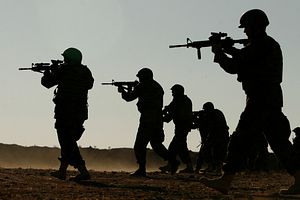The Special Inspector General for Afghanistan Reconstruction (SIGAR) October quarterly report to Congress painted a grim picture for Afghan reconstruction and highlighted that many gains by Afghan and U.S. forces over the years have been overturned.
Despite the grim outlook, Taliban forces have shed considerable blood for modest gains in rural Afghanistan. The so-called hard status quo between Afghan forces and the Taliban has been maintained as the resurgent militant force has failed to occupy any major population center, a stated goal of the Taliban’s operation Omari launched this spring.
Cited in the report, “approximately 63.4 percent of the country’s districts are under Afghan government control or influence as of August 28, 2016, a decrease from the 65.6 percent reported as of May 28, 2016.” However, according to General John Nicholson, commander of the Resolute Support mission in Afghanistan, “68–70 percent of the population lived in those districts.”
According to the SIGAR report, “of the 407 districts within the 34 provinces, 258 districts were under government control (88 districts) or influence (170), 33 districts (in 16 provinces) were under insurgent control (8) or influence (25), and 116 districts were contested.”
Afghan forces continue to see record casualties: “from January 1, 2016, through August 19, 2016, 5,523 ANDSF [Afghan National Defense and Security Forces] service members were killed and an additional 9,665 members were wounded.” According to a United Nations report, roughly 5,100 civilians were killed or wounded during the first half of 2016, partially as a result of expanded air operations by Afghan forces as the Afghan government has incorporated new air frames such as the A-29 Super Tucano, a propeller based fixed wing ground attack aircraft.
In a separate SIGAR report on Afghanistan’s road infrastructure, SIGAR cited an official with the Ministry of Public Works (MOPW), saying “20 percent of Afghanistan’s roads were destroyed and the remaining 80 percent continue to deteriorate,” he stated. Furthermore, the MOPW noted, “Afghanistan’s road infrastructure plays an important role in the country’s development and governance, and if the Kabul to Kandahar highway were to become impassable, the central government would collapse.”
However, despite the grim picture painted by SIGAR, the 2016 bloody fighting season may have made the Taliban more amenable to peace negotiations. A leaked letter from the former senior aid to Mullah Omar, Mohammad Tayyeb Agha, has highlighted deep dissension and factionalism within the Taliban.
In his letter, Agha called on Taliban leaders to return to Afghanistan, cut ties with Pakistan, abandon claims of the Islamic Emirate of Afghanistan, and to appeal to larger swaths of the Afghan population.
Having mounted the largest offensive operation since the 2001-led U.S. invasion, the Taliban have largely failed in capturing any major cities, a stated goal of the resurgent militant group when it launched its spring offensive, dubbed Operation Omari. High casualty rates from failed assaults on Kunduz, Lashkar Gah, and Farah have increased disputes and tension among rank and file Taliban.
“From March until the end of July, the Afghan forces were on the offense and had all of the momentum. In August, however, the Taliban began to try to take over a provincial capital — Lashkargah, Kunduz, and then Tirinkot. Although it is not difficult for a smaller force to conduct raids, the Taliban have not been able to achieve their goal of taking major population center,” General Cleveland, spokesman for Resolute Support, said.
“If we don’t pay attention [to reform and change], the Taliban and our jihad will become loathsome,” Agha wrote to Akhundzada. Fearing a disintegration of the Taliban into roaming bandits and splinter groups, Agha has called on the Taliban to pursue reform, to include negotiations with the Afghan government.
Many challenges and hurdles remain for the Afghan government as they search for peace and reconciliation in the war torn region. The October SIGAR reports once again have highlighted a challenging landscape for the Kabul government as it steers a ship toward self-sufficiency and peace with a resurgent militant group.
Taliban gains in rural Afghanistan have come at a steep cost, and the failure to achieve strategic goals during 2016 has increased dissension among Taliban fighters and its leadership. The hard status quo in Afghanistan is still in play, neither the Taliban nor the Afghan government contains the capacity to defeat each other on the battlefield. Possibly, the time is near for both sides to realize that space and time have caught up, and negotiations will be the only way forward.

































